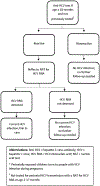CDC's New Hepatitis C Virus Testing Recommendations for Perinatally Exposed Infants and Children: A Step Towards Hepatitis C Elimination
- PMID: 38476092
- PMCID: PMC11182722
- DOI: 10.1089/jwh.2023.1114
CDC's New Hepatitis C Virus Testing Recommendations for Perinatally Exposed Infants and Children: A Step Towards Hepatitis C Elimination
Abstract
New U.S. Centers for Disease Control and Prevention (CDC) guidelines for hepatitis C virus (HCV) testing of perinatally exposed infants and children released in 2023 recommend a nucleic acid test (NAT) for detection of HCV ribonucleic acid (i.e., NAT for HCV RNA) at 2-6 months of age to facilitate early identification and linkage to care for children with perinatally acquired HCV infection. Untreated hepatitis C can lead to cirrhosis, liver cancer, and premature death and is caused by HCV, a blood-borne virus transmitted most often among adults through injection drug use in the United States. Perinatal exposure from a birth parent with HCV infection is the most frequent mode of HCV transmission among infants and children. New HCV infections have been increasing since 2010, with the highest rates of infection among people aged 20-39 years, leading to an increasing prevalence of HCV infection during pregnancy. In 2020, the CDC recommended one-time HCV screening for all adults aged 18 years and older and for all pregnant persons during each pregnancy. Detecting HCV infection during pregnancy is key for the identification of pregnant persons, linkage to care for postpartum treatment, and identification of infants with perinatal exposure for HCV testing. It was previously recommended that children who were exposed to HCV during pregnancy receive an antibody to HCV (anti-HCV) test at 18 months of age; however, most children were lost to follow-up before testing occurred, leaving children with perinatal infection undiagnosed. The new strategy of testing perinatally exposed children at age 2-6 months was found to be cost-effective in increasing the identification of infants who might develop chronic hepatitis C. This report describes the current perinatal HCV testing recommendations and how they advance national hepatitis C elimination efforts by improving the health of pregnant and postpartum people and their children.
Keywords: HCV; hepatitis C; perinatal infection; vertical transmission.
Figures
References
-
- Wilkins T, Malcolm JK, Raina D, et al. Hepatitis C: Diagnosis and treatment. Am Fam Physician 2010;81(11):1351–1357. - PubMed
-
- Centers for Disease Control and Prevention. Division of Viral Hepatitis 2025 Strategic Plan. CDC; 2020.
MeSH terms
Grants and funding
LinkOut - more resources
Full Text Sources
Medical



